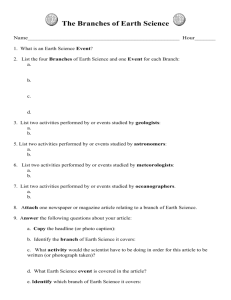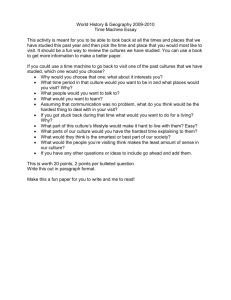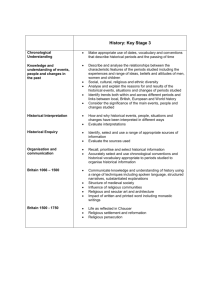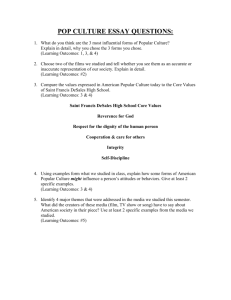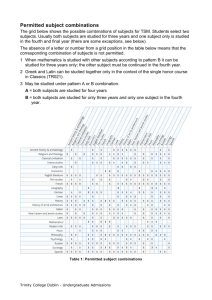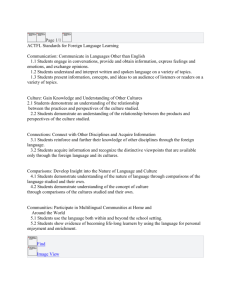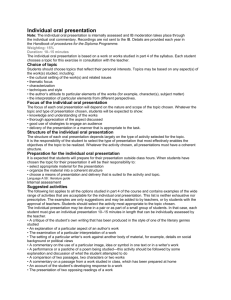Alfred Adler Neo-Freudian but disagreed with Freud's emphasis on
advertisement
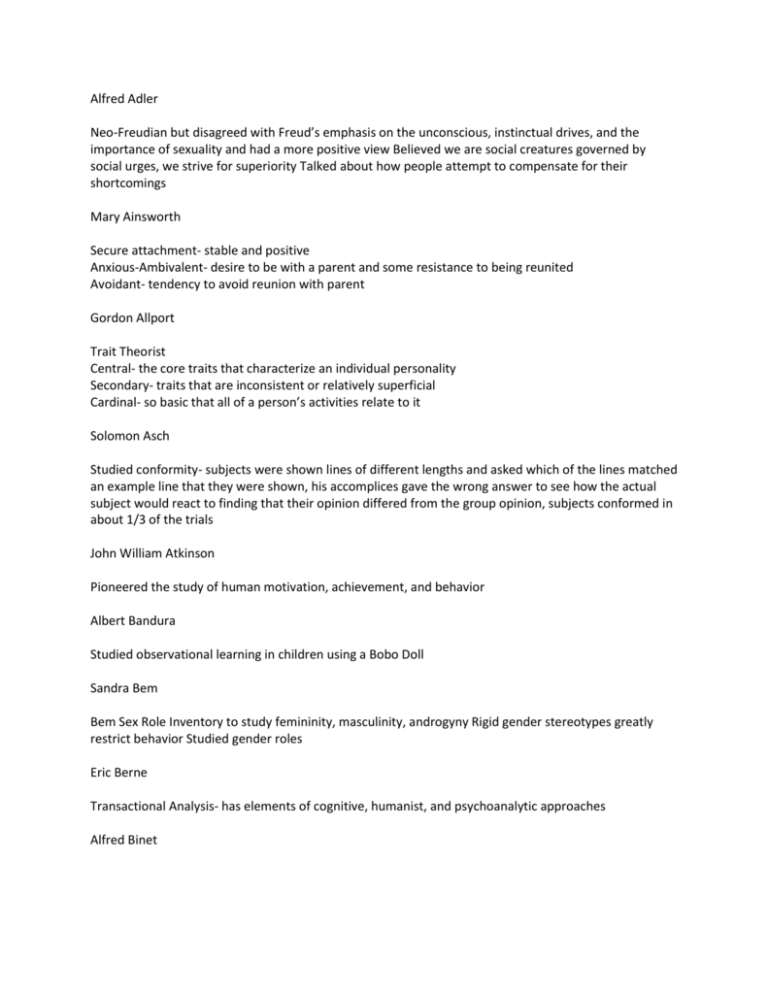
Alfred Adler Neo-Freudian but disagreed with Freud’s emphasis on the unconscious, instinctual drives, and the importance of sexuality and had a more positive view Believed we are social creatures governed by social urges, we strive for superiority Talked about how people attempt to compensate for their shortcomings Mary Ainsworth Secure attachment- stable and positive Anxious-Ambivalent- desire to be with a parent and some resistance to being reunited Avoidant- tendency to avoid reunion with parent Gordon Allport Trait Theorist Central- the core traits that characterize an individual personality Secondary- traits that are inconsistent or relatively superficial Cardinal- so basic that all of a person’s activities relate to it Solomon Asch Studied conformity- subjects were shown lines of different lengths and asked which of the lines matched an example line that they were shown, his accomplices gave the wrong answer to see how the actual subject would react to finding that their opinion differed from the group opinion, subjects conformed in about 1/3 of the trials John William Atkinson Pioneered the study of human motivation, achievement, and behavior Albert Bandura Studied observational learning in children using a Bobo Doll Sandra Bem Bem Sex Role Inventory to study femininity, masculinity, androgyny Rigid gender stereotypes greatly restrict behavior Studied gender roles Eric Berne Transactional Analysis- has elements of cognitive, humanist, and psychoanalytic approaches Alfred Binet Designed the first intelligence test made up of “intellectual” questions and problems, results were based on average scores for children in each age group His test was revised by Lewis Terman and others at Stanford and made into the Stanford-Binet Intelligence Scales, which were used in North America Bowlby Child development Attachment theory James Cattell First professor of psychology in the United States, helped establish psychology as a legitimate science Raymond Cattell 16 Trait Personality Inventory Surface traits appear in clusters, 16 source traits Factor analysis Jean-Martin Charcot Known as the founder of modern neurology, taught and influenced Freud Noam Chomsky Proposed an innate language acquisition device John Dollard & Neal Miller Habits make up the structure of personality and are governed by drive, cue, response and reward Hermann Ebbinghaus Forgetting curve Paul Ekman Pioneer of the study of emotions and their relation to facial expressions Developmental psychologist Albert Ellis Cognitive therapist, founder of rational emotive behavioral therapy which attempts to change irrational beliefs that cause emotional problem Erik Erikson Proposed that development occurs in stages, each stage confronts a person with a new developmental task Trust v. Mistrust, autonomy v. shame and doubt, initiative v. guilt, industry v. inferiority, identity v. role confusion, intimacy v. isolation, generativity v. stagnation, integrity v. despair Hans Eysenck Trait theorist Big 3- melancholic, choleric, phlegmatic Leon Festinger Cognitive dissonance Frankl Existential therapist Logotherapy- emphasized the need to find and maintain meaning in life Anna Freud Neo-Freudian Disagreed with Freud’s theories about women Sigmund Freud Founder of psychoanalysis Id, Ego, Superego Many of our behaviors are driven by unconscious motives/desires John Garcia Studied taste aversion in rats with radiation, decided there was an evolutionary element to taste aversion Howard Gardner Theorized that there are actually eight different kinds of intelligence Language, logic and math, visual and spatial thinking, music, bodily-kinesthetic kills, intrapersonal skills, interpersonal skills, naturalist skills Carol Gilligan Created a theory of moral development in women because male psychologists were overly focused on defining moral maturity in terms of justice and autonomy. She pointed out that there is also an ethic of caring about others that is a major element of moral development. G. Stanley Hall Founded the American Journal of Psychology Harry Harlow Seperated baby rhesus monkeys from their mothers at birth, placed with surrogate mothers either made of wire/metal or cloth, studied mother-infant relationships and discovered Contact Comfort Heider Gestalt Balance theory, attribution theory Hilgard Researched hypnosis and its effectiveness as an analgesic “hidden-observer” effect Karen Horney Neo-Freudian Among the first to challenge the obvious male bias in Freud’s theories, also disagreed with his cause of anxiety- believed that people feel anxious because they feel isolated and helpless in a hostile world, believed causes are rooted in childhood Clark L. Hull Drive theory Modern study of hypnosis Izard Believes the infants can express several basic emotions as early as 10 weeks of age William James Wrote Principles of Psychology and helped establish psychology as a serious discipline, regarded consciousness as a stream or flow of images and sensations Mary Jones Pioneer of behavior therapy Unconditioned a fear of rabbits in a three year old named Peter Carl Jung People are either introverts or extroverts Collective unconscious- mental storehouse for unconscious ideas and images shared by all humans, such universals create archetypes Anima (female principle) & Animus (male principle) exist in everyone Kagan Showed face masks to 2-yr-olds and found they were fascinated when they saw faces with features in the wrong places Grace Helen Kent Kent-Rosanoff free association test- psychiatric screening tool using objective scoring and norms Alfred Kinsey Studied human sexuality Kurt Koffka Co-founder of Gestalt psychology Wolfgang Kohler Co-founder of Gestalt psychology Studied insight learning in chimpanzees Lawrence Kohlberg Studied moral development in men Preconventional- Stage 1: punishment orientation Stage 2: pleasure-seeking orientation Conventional- Stage 3: Good boy/ good girl orientation Stage 4: Authority orientation Postconventional- Stage 5: social-contract orientation Stage 6: Morality of individual principles Elizabeth Kubler-Ross Thanatologiest- one who studies death Reactions to impending death- denial and isolation, anger, bargaining, depression, acceptance Elizabeth Loftus Along with John Palmer showed people a filmed automobile accident, asked how fast cars were going when they smashed or bumped or contacted, asked if they had seen broken glass in the film (there was none) to study the tendency of people to construct memories based on how they are questioned Konrad Lorenz Discovered the principle of imprinting Studied instinctive behavior in animals Marcia Studied adolescent psychological development, elaborated on Erikson’s theories Theory of identity achievement Abraham Maslow Humanist Self-Actualization was important Hierarchy of human needs- physiological needs, safety and security, love and belonging, esteem and self-esteem, self-actualization William Masters & Virginia Johnson Directly studied sexual intercourse and masturbation in nearly 700 males and females Sexual response can be divided into four phases: excitement, plateau, orgasm and resolution McClelland Believes that IQ is of little value in predicting real competence to deal effectively with the world IQ predicts school performance, not success in life Margaret Mead Anthropologist who observed the Tchambuli people of New Guinea, where gender roles are the opposite of those in America Franz Mesmer Austrian physician who believed he could cure disease with magnets His treatments were based on the power of suggestion, not really magnetism and he was later rejected as a fraud The term “mesmerize” comes from his name, his treatments sparked interest in hypnosis Wolfgang Metzger Gestalt psychologist Stanley Milgram Studied obedience Two subjects (“teacher” and “learner”) but the “learner” was actually an actor. The teacher was told to shock the learner every time they answered a question incorrectly to see how far they were willing to go. Walter Mischel Ivan Pavlov Studied classical conditioning Paired a bell with food to make dogs salivate Fritz Perls Originator of Gestalt therapy Considered most dreams a special message about what’s missing in our lives, what we avoid doing, or feelings that need to be “re-owned” Believed that dreams are a way of filling in gaps in personal experience Method of analyzing dreams involved speaking for characters and objects in your dreams Jean Piaget Child development occurs in stages Sensorimotor, preoperational, concrete operational, formal operations Robert Rajonc Vilayunar S. Ramachandran Rescorla Stated that the predictive value of a conditioned stimulus is critical, contingencies are important Carl Rogers Humanist Emphasized the human capacity for inner peace and happiness People need ample amounts of love and acceptance from others Hermann Rorschach Created the Rorschach inkblot test, a projective test of personality Julian Rotter Daniel Schacter Stanley Schachter Emotion occurs when we apply a particular label to general physical arousal- we have to interpret our feelings Roy Schafer Margaret Singer Studied and aided hundreds of former cult members Cults use a powerful blend of guilt, manipulation, isolation, deception, fear, and escalating commitment Martin Seligman Prepared fear theory- we are prepared by evolution to readily develop fears to certain biologically relevant stimuli, such as snakes and spiders Hans Selye Studied stress- the body responds in the same way to any stress (infection, failure, embarrassment, a new job, trouble at school etc.) General Adaptation Syndrome- a series of bodily reactions to prolonged stress (alarm, resistance, exhaustion) B. F. Skinner Studied operant conditioning with rats and pigeons Created a Skinner Box Charles Spearman Robert Sternberg Triangular theory of love- love is made up of intimacy, passion and commitment which can combine to produce seven types of love (romantic, liking, fatuous, infatuation, companionate, empty, consummate) Believed insight involved selective incoding, selective combination, and selective comparison Szasz Lewis Terman Revised Binet’s intelligence test to help create the Stanford-Binet Intelligence Scales for use in North America, appropriate for people ages 2-90 Edward L. Thorndike Learning theorist Law of Effect- the probability of a response is altered by the effect it has, acts that are reinforced tend to be repeated L. L. Thurstone Edward Titchener Carried Wundt’s ideas into the United States and called them structuralism Tolman & Honzik Studied latent learning in rats with mazes Torrey Endel Tulving Lev Vygotsky Sociocultural theory Children’s thinking develops through dialogues with more capable persons, children actively seek to discover new principles Zone of proximal development- range of tasks a child cannot yet master alone but that she or he can accomplish with the guidance of a more capable partner John B. Watson Behaviorist Objected to the study of the mind or conscious experience, thought introspection was unscientific Observed stimuli and response, adopted Pavlov’s concept of conditioning David Wechsler Intelligence testing Max Wertheimer First to advance the Gestalt viewpoint, thought it was a mistake to break psychological experiences down into smaller pieces to analyze Benjamin Lee Whorf Wilhelm Wundt Father of psychology- set up the first psychological laboratory to study conscious experience Introspection Yerkes & Dodson Yerkes Dodson law- the ideal level of arousal depends on the complexity of a task: If the task is more complex your performance will be better at lower levels of arousal If the task is simple it is best for arousal level to be high Philip Zimbardo Stanford prison experiment Students volunteered to play the roles of prisoners and guards, experiment had to be called off after 6 days, rather than the planned 2 weeks because the guards had become so sadistic that four of the ten prisoners suffered severe emotional issues
